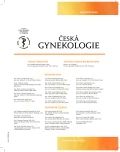-
Medical journals
- Career
Acute uterine inversion after delivery
Authors: E. Pechová 1; I. Bydžovská 1; M. Krausová 1; M. Lubušký 2
Authors‘ workplace: Gynekologicko-porodnické oddělení, Krajská nemocnice, Liberec, primář MUDr. P. Černý 1; Porodnicko-gynekologická klinika LF UP a FN, Olomouc, přednosta prof. MUDr. R. Pilka, Ph. D. 2
Published in: Ceska Gynekol 2016; 81(5): 394-397
Overview
Objective:
A case of acute inversion of the uterus after childbirth, in which we successfully perform a manual vaginal reposition of the uterus.Design:
Case report.Setting:
Department of Obstetrics and Gynaecology, Krajská nemocnice Liberec, a.s.; Department of Obstetrics and Gynaecology, Palacky University Hospital, Olomouc.Observation:
Our case report describes acute post-partum uterine inversion of the second degree, which developed after delivery in a 36-year-old primigravida. The placenta was not delivered despite uterotonics administration, use of the Credé manoeuvre and controlled umbilical cord traction. We decided for manual removal of the placenta in general anaesthesia. After successful removal of the placenta, uterine inversion was diagnosed. Therefore, we immediately started with vaginal reposition and the manual reposition of the uterus successful. Total blood loss amounted to approx. 2500 ml and the patient fell into the shock state. Severe coagulopathy was diagnosed using rotational thrombelastography. We were able to stabilise the condition of the patient and on the eigth day after delivery she was discharged home.Conclusion:
Uterine inversion is a rare complication of the third labour stage. Some obstetricians do not encounter this condition in their entire practice, but it can be cause of maternal mortality. Therefore, it is necessary that every obstetrician considers this possibility, knowing the risk factors and the therapeutic options in this critical situation.Keywords:
vaginal delivery, uterine inversion, peripartal life-threatening bleeding, maternal mortality
Sources
1. Baskett, T. Acute uterine inversion: a review of 40 cases. J Obstet Gynaecol Can, 2002, 24, p. 953–956.
2. Beringer, R., Patteril, M. Puerperal uterine inversion and schod. Br J Anaesth, 2004, 92, p. 439–441.
3. Dosedla, E., Frič, D. Richnavský, J. Lukačín, Š. Akútna inverzia maternice:analýza 3 prípadov. Actua. Gyn, 2011, 3, s. 1–4.
4. Goeckenjan, M., et al. Inversio uteri. Gynäkologe, 2008, 41, 6, p. 412–418.
5. Hájek, Z., Krejčí, V. Inverze dělohy. In: Pařízek, A., et al. Kritické stavy v porodnictví. Kamenice: Mother-Care-Centrum Publishing, 2012, s. 150–151.
6. Mlynček, M. Chirurgické metódy zastavenia postpartálneho krvácania. Gynekol pre prax, 2014, 12, 4, s. 202–206.
7. Pešková, I. Inverze dělohy po porodu - kazuistika. Actual Gyn, 2015, 7, s. 12–14.
8. Platt, LD., Druzin, ML. Acute puerperal inversion of the uterus. J Obstet Gynecol, 1981, 141, p. 187-190.
9. Swati, A., et al. Subacute puerperal third degree uterineinversion – a rare case. Amer J medical case reports. 2013, 1, 1, p. 9-11.
10. Ward, HR. O'Sullivan`s hydrostatic reduction of an inverted uterus: sonar sequence recorded. Ultrasound Obstet Gynecol, 1998, 12, p. 283–286.
11. Zikmund, J. Nepravidelnosti III. doby porodní a poporodního období. In: Čech, E., Hájek, Z., Srp, B., Maršál, K. Porodnictví. 2. přepracované vyd. Praha: Grada, 2006, s. 358–360.
Labels
Paediatric gynaecology Gynaecology and obstetrics Reproduction medicine
Article was published inCzech Gynaecology

2016 Issue 5-
All articles in this issue
- Ultrasound comparison of adjustable single-incision (Ajust) and transobturator tapes to assess post-operative fixation and function and clinical efficacy
- Histopathological changes in placental tissue with connection to chosen clinical cases in obstetrics
- Sexual morbidity of cervical carcinoma survivors
- Postpartum blues – a Czech adaptation of the Maternity Blues Questionnaire
- Current knowledge about HPV infection
- Peripheral precocious puberty
- Nonculture techniques of microorganisms determination in amniotic fluid in patients with preterm prelabor rupture of membranes
- Acute myocardial infarction complicated pregnancy of patient after kindey transplantation and knee osteosarcoma
- Acute uterine inversion after delivery
- The effect of erythropoietin on uterus inflammation during ischemia reperfusion injury in rats
- Czech Gynaecology
- Journal archive
- Current issue
- Online only
- About the journal
Most read in this issue- Peripheral precocious puberty
- Current knowledge about HPV infection
- Sexual morbidity of cervical carcinoma survivors
- Acute uterine inversion after delivery
Login#ADS_BOTTOM_SCRIPTS#Forgotten passwordEnter the email address that you registered with. We will send you instructions on how to set a new password.
- Career

